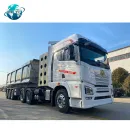A Guide to Choosing the Right Capacity and Size for Your Tipper Truck
Introduction:
Tipper trucks, also known as dump trucks, are essential vehicles in construction, mining, and various industries where the transportation of bulk materials is a daily requirement. Selecting the right capacity and size for a tipper truck is crucial to ensure efficiency, safety, and cost-effectiveness in your operations. This guide will help you navigate the key considerations when choosing a tipper truck.
Payload Capacity: One of the primary considerations is the payload capacity—the amount of material a tipper truck can carry. This capacity is determined by the volume of the truck's bed and the density of the material being transported. Consider the average weight of the materials you will be hauling, and choose a tipper truck with an appropriate payload capacity.
Truck Size and Configuration: Tipper trucks come in various sizes and configurations, including single-axle, tandem axle, and multi-axle options. The size and configuration impact the overall weight-bearing capacity and maneuverability of the truck. Assess your operational needs, road conditions, and the accessibility of your work sites when choosing the right size and configuration.

Body Type: dump Tipper trucks have different body types, such as standard bodies, high-sided bodies, and bodies with additional features like automatic tailgates. The choice of body type depends on the type of materials you'll be transporting and the efficiency of unloading. High-sided bodies are suitable for loose materials, while standard bodies are versatile for various applications.
Terrain and Road Conditions: Consider the terrain and road conditions where your tipper truck will operate. Off-road or challenging terrains may require a truck with robust suspension, powerful engines, and sturdy construction to handle the demands of uneven surfaces.
Additional reading:The Versatile Sidewall Trailer: A Workhorse of Transportation
5 Tips for Choosing the Best Electric Motorcycle
Why I chose a base camp trailer as my full-time RV home
How Big Should a Pipe Sleeve Be?
Camping Trailer vs. Travel Trailer: A Comprehensive Comparison Guide
How long is a semi-truck with 53 trailer?
Semi Trailer China
Regulatory Compliance: Ensure that the tipper truck you choose complies with local regulations regarding weight restrictions and axle load limits. Non-compliance can result in fines and operational disruptions.
Engine Power and Fuel Efficiency: The power of the truck's engine is critical for hauling heavy loads efficiently. Choose a tipper truck with an engine that provides sufficient power for your operational needs. Additionally, consider fuel efficiency to minimize operational costs over the long term.
Manufacturer Reputation: Opt for tipper trucks from reputable manufacturers known for producing reliable and durable vehicles. A well-established manufacturer is more likely to provide quality engineering and after-sales support.
Cost Considerations: While it's essential to invest in a truck that meets your operational requirements, also consider your budget. Evaluate the total cost of ownership, including maintenance and fuel costs, to make an informed decision that aligns with your financial constraints.
Conclusion:
Choosing the right capacity and size for your tipper truck involves a careful assessment of your operational needs, materials to be transported, and the specific conditions of your work sites. By considering payload capacity, dump truck size and configuration, body type, terrain, regulatory compliance, engine power, manufacturer reputation, and cost factors, you can make an informed decision that enhances the efficiency and effectiveness of your tipper truck operations.
If you are interested in sending in a Guest Blogger Submission,welcome to write for us!




Comments
0